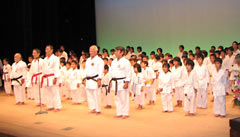Karate and traditional martial arts symposium held in Naha

On October 20, at the Palette Civic Theater in Naha, the symposium “Naha, Home of karate and traditional Martial Arts 2012” was held.
October 23, 2012 Ryukyu Shimpo
On October 20, the Naha Karate Association (NKA) and Naha Municipal Government held a symposium entitled “Naha, Home of Karate and Traditional Martial Arts 2012” at Palette Civic Theater in Naha. They recommended that karate be expanded globally and suggested Naha as the venue for the Karate-do Hall that the Okinawa Prefectural Government is planning to establish.
Seitoku Ishikawa, the head of the Okinawa Shorin-ryu Karate-Do Association is probably the only person who understands the traditions of karate in pre-war Okinawa. He stated in his speech that in the past karate was concealed from others, and that a recommendation from a person with some standing in society was required in order to be accepted to learn karate. In order to test their determination people asking to be mentored were refused every day for a week. “The most important thing in karate is character development. We have to be conscious of our role as leaders in society,” said Ishikawa.
In the panel discussion, representatives of Goju-ryu, Shorin-ryu and Matsubayashi-ryu talked about the origins of karate: the Naha style, the Shuri style and the Tomari style. They explained the features unique to each style. The Shuri style used a makiwara, a post wrapped in straw for training, and its exponents tried to focus all their strength in split seconds of action. The Naha style is more orthodox and respects good manners. The Tomari style aims to develop a student’s character and trains them with that in mind.
Head of the Secretariat of the Okinawa Traditional Karate Liaison Bureau, Miguel Da Luz, explained that there are 60 million karate fans around the world and that karate has been gaining popularity quite independent of the Okinawan influence. He said, “If people learn the history of karate, they will want to come to Okinawa. Exponents of karate will come to Okinawa hoping to understand its spirit and to foster karate camaraderie.” He insisted that, in order to meet the expectations of people’s passion for karate, it needs to be advertised even more and taken to every corner of the globe.
Towards the end of the symposium, all in unison, some 150 children between kindergarten and junior high school age who go to NKA practice halls said, “We are proud of Naha as the home of karate and traditional martial arts. We will practice hard and be polite. We will expand our exchange with our friends around the world.”
(English translation by T&CT, Lima Tokumori and Mark Ealey)
Previous Article:Kitanakagusuku pupils receive e-learning ESL from an American university
Next Article:Second A-lunch Championship held in Okinawa City
[Similar Articles]
- Worldwide karate seminar held in Yomitan
- Karate demonstration on Karate Day
- Strengthen your immune system with radio karate along with a Naha Tomari Elementary school teacher
- “The Martial Art of Peace,” the essence of Okinawa Karate, performed by 5 top Karate figures for Karate Day celebration
- Symposium to talk about creating Okinawan karate brand
 Webcam(Kokusai Street)
Webcam(Kokusai Street)


